Battling Butler, Seven Chances, The Navigator (1924, 1925, 1926)
Directed by: Buster Keaton, Donald Crisp
Written by: Clyde Bruckman
Starring: Buster Keaton, Kathryn McGuire, Sally O' Neil, Snitz Edwards
USA
AVAILABLE ON BLU-RAY: NOW, from EUREKA ENTERTAINMENT
RUNNING TIME: 204 mins [THE NAVIGATOR 66 mins, SEVEN CHANCES 56 mins, BATTLING BUTLER 77 mins]
AVAILABLE ON BLU-RAY: NOW, from EUREKA ENTERTAINMENT
It was back in 2016 when I received Eureka Entertainment’s collection of Buster Keaton: The Complete Short Films, which was several hours of inventive fun, crazy mayhem and down right genius which blew me away. When I was a kid, I became a lover of Harold Lloyd, Charlie Chaplin and Laurel and Hardy due to their work often being shown on TV, but Keaton’s stuff for some reason didn’t tend to be on nearly as much and subsequently I only got to know his work a little bit from clips and how much one of my movie icons Jackie Chan was influenced by him, to the point of actually re-using, then tweaking, some gags. Fast forward a few years and I didn’t get the chance to review Eureka’s first Keaton feature threesome consisting of Sherlock Jr., The General and Steamboat Bill Jr, though by then I’d already seen the first two of those films anyway as they seem to be Keaton’s two best known pictures. But are they his best? They’re often considered to be, though there was little doubt whatsoever in my mind that this second trilogy would give them a run for their money, at least in places if maybe not as a whole. In fact there are indeed highlights which are just as good – or dare I say in some cases even better – even if two of the films are a tad less satisfying as a whole. That’s not to put them down though – they’re still wonderful – while one of them is quite simply another masterpiece in my opinion and had me laughing and gasping so much that it was starting to affect my breath!
Wealthy Rollo decides to marry his sweetheart Betsy and sail to Honolulu, but she rejects him so he decides to go alone but boards the wrong ship, the “Navigator” owned by Betsy’s father which he’s just sold to a country at war. Unaware of this, Betsy also boards the ship to look for her father, whom enemy spies capture before cutting the ship loose. It drifts out to sea with Rollo and Betsy each unaware of there being anyone else on board….
This was Keaton’s biggest hit after the commercial disappointment that was Sherlock Jr. and was considered by him to be his best film. It’ s certainly up there. It’s very episodic and not particularly hot on plot, the finale leaving us with many matters unresolved. But does this really matter when we’re treated to a non-stop series of funny gags and an almost epic action climax? Probably not. Keaton’s Rollo, “a living proof that every family tree must have its sap” as the inter-titles tell us, is a pampered individual who probably wouldn’t cope whatsoever without his servants, and Betsy is only slightly more capable. Jokes are minimised in the set-up that is the first ten minutes, so we can enjoy all the more the incredible sequence where Rollo and Betsy are each trying to find the other person who must be on the ship, beginning with her walking right past him unnoticed and climaxing with the two running round and round the ship [at one point you can see Kathryn McGuire with a huge smile on her face trying not to laugh if you look closely!] and then Rollo getting sucked into a funnel to land right beside Betsy and repeat the last words he spoke to her again, ”Will you marry me”? It’s truly brilliant stuff, with lots of great wide shots showing off the meticulous choreography, while of course it’s all obviously staged on an actual ship. Then the two try to make dinner, but Rollo can’t even open a can. They still manage to live on the increasingly rocky ship for some time [in separate beds of course], and I’d have been perfectly happy for the rest of the film to be about that, while the civil war that’s going on in this un-named country is forgotten about, but instead we get an attack by hordes of natives of an island which may irritate some of the PC lot but is really a terrific melding of thrills and humour, then a submarine gag partly copied in You Only Live Twice.
The pace only flags ever so slightly when Rollo is underwater, but seeing as Keaton actually is actually under Lake Tahoe in person I think we can forgive this, and where else do you get to see a diver doing things like use a swordfish to fence with another swordfish? Keaton’s subtly expressive acting, by someone nicknamed ‘Stone Face’ who certainly did not adhere to the usual style of silent movie performing, while encumbered in the suit, is also notable. As usual, he maintains a poker face throughout no matter what obstacle is thrown at him. though my favourite gag was a smaller one involving a portrait which ends up terrifying Rollo when Betsy throws it aside and it lands by Rollo’s window and swings back and forth so he thinks he’s seeing a ghost. Keaton’s energy, perfectionism and bravery [look at the way he narrowly misses being seriously injured by a small cannon, a scene copied almost shot for shot in no less than the The Phantom Menace with Jar Jar Binks by the way] is amazing, but I should also praise his co-star Kathryn McGuire who’s asked to do a hell of a lot and who shares considerable chemistry with Keaton even if we tend to forget their ‘personal’ story due to all the lunacy going on. You can possibly look at The Navigator as an examination of the still timely idea of ‘civilised’ man versus the machine, the latter seen as making life difficult for us because we’ve become so dependent on it and it’s not always reliable. I see it as a breathless series of happenings that race past you while you’re too busy laughing and asking yourself, “did I really see that”? to ponder on any deep themes.
Eureka are basically using the Region ‘A’ Cohen Media releases – though possibly giving the films a new encode – but importing some of the extras from the earlier Kino versions, and adding some special features of their own. The Coen Media Group-commissioned restorations were done at L’Immagine Ritrovata but the yellow bias is relatively minimal – it’s there, but it’s not distracting. Kino’s were tinted. The Navigator certainly looks superb for a film from 1924, surprisingly sharp and detailed, and it’s graced with a fun music score by Robert Israel which sounds exactly as we imagine a silent comedy score to sound.
Though we don’t get the two short Cohen pieces, Eureka have included the two special features on the Kino and added a third. There’s a warning just before the start of the audio commentary which tells us that it was originally recorded for a version of the film that ran faster and therefore Eureka had to synch it up to their version resulting in audio quality not being as good. Indeed Kino’s release ran six minutes less than Eureka’s. The sound really isn’t that great at all, tinny and muffled, and I had to turn the volume on my player way up to hear all of it, which is a shame because Robert Arkus and Yair Solon, clearly fans of and experts on Buster, provide a fine track combining information with commentary and insight. We learn that Keaton almost suffocated to death in his diving helmet, the history of the ship used, and an elaborate underwater scene that was cut out. Boats, Brides and Boxers is a typically good video essay from the always erudite David Cairns with input from Imogen Sara Smith, but I recommend that you leave off watching it until you’ve seen the other two films. We get an idea of what made Keaton so unique before going through these three pictures. Even here, we learn a few things, such as Keaton having a director forced upon him for Seven Chances, whereupon he gave him nothing to do so he eventually gave up and left. Some of the clips are not of the Eureka versions, they’re a bit more white and a bit less yellow. And Of Buster, Boats, Other Seacraft and Working on The Navigator is also from the Kino, a making of that not just shows but references Kino’s tinted version. It goes into Keaton’s fascination with water, how he had two main character types – the everyman and the pampered sophisticate – and tells us that Keaton actually re-shot much of Crisp’s work.
Jimmie is the junior partner in the brokerage firm of Meekin and Shannon which is nearly bankrupt. An attorney presents him his grandfather’s will leaving him seven million dollars, though it also says that he will only get the money if he’ married by 7pm on his 27th birthday – which happens to be that very same day! Having no luck with his sweetheart, Mary Jones, Jimmie is persuaded by Meekin to try proposing to other women to save them both from ruin or possibly even jail….
By contrast, Seven Chances was a movie which Keaton didn’t like much at all and tried to prevent the restoration and re-release the only known copy of the movie – though he changed his mind about it when it was re-released just before his death. Perhaps some of this was due to the fact that it was a project which he didn’t initiate and was foistered upon him. It actually feels more like a Harold Lloyd film in places, but that’s not at all to say that it doesn’t contain much brilliance. Based on a play of the same name by Roi Cooper Megrue which also inspired The Batchelor, it’s less episodic than its predecessor, instead exploiting one situation for all its worth before most of the second half is taken up by an increasingly elaborate chase. It opens in great fashion in Technicolor with four almost identical shots of Jimmie and Mary standing outside her house with its white picketed fence during the four seasons while he repeatedly tells her that he loves her. Jimmie’s proposal to Mary is a cute scene – he’s practicing his speech while not noticing that Mary is sitting right beside him – and immediately accepts. However, when he tells her of why he’s doing this she changes her mind, so he sets about proposing to “everything in skirts, including a Scotchman”, as the inter-titles tell us, beginning with an attempt in a restaurant where the lady concerned and everyone else there burst into laughter. In fact this one relies rather more on inter-titles than The Navigator, and after a while the main joke is stretched rather thin even though many chuckles still result, such as the only keen woman being under-age so her mother quickly snatches her from him. Fortunately the lengthy climax of Jimmie fleeing from loads of women [and men dressed as women] more than makes up for this, with stunners such as Keaton hanging on a crane, jumping onto a tree and dodging hundreds of boulders, a scene he thought up when preview audiences laughed when he inadvertently dislodged some rocks which tumbled down after him as if in pursuit and he had to scramble to dodge them.
Other high points are Jimmie trying to find out the time with no luck despite watches and clocks being everywhere, and Jimmie before a mirror being spooked when the mirror turns out to be part of a door and a person steps out when he turns his head away for a second. Keaton spends much of this one with an appropriately exasperated look on his face, yet still keeps his cool. His direction has some quirky touches, like him in his car about to set off somewhere dissolving straight to the car at its destination in the same position on the screen, or some lingering on a peripheral character you never ever see again. It’s possible that some modern viewers may liken Jimmie’s actions to sexual harassment, though it must be said that the women give as good as they get. We also get a stereotypical black-faced servant that may ruffle a few feathers, even though this kind of portrayal was the norm at the time and this one is a lot more positive than some. And a scene where Jimmie approaches yet another woman to ask to marry before he notices that she’s black and instantly stops doesn’t strike me as being especially racist seeing as interracial marriages were illegal at the time, though it will no doubt come across as such to many. While not quite the non-stop highlight reel that is The Navigator, Seven Chances is still generally funny and clever, certainly more so than any recent movie comedy I’ve seen.
The Technicolor opening looks like several generations down from the rest of the print which looks almost as pristine as The Navigator. Occasional shots look almost too pristine, as if some digital tweaking has been done, but that would be down to Cohen, not Eureka. The slight yellow bias isn’t particularly irritating. Another fine Robert Israel score provides the musical backing. Israel did these scores for the 1995 releases, and thankfully have remained on all versions of the films since then.
This time two other silent movie buffs Joel Goss and Bruce Lawton provide the audio commentary. They aren’t quite so informative as Arkus and Solon, often preferring to just show how much they love what’s taking place on screen, while Solon doesn’t exactly say much. They talk a lot about Raymond Rohauer without explaining who he was to those not in the know [he restored and re-released a lot of silent movies in the ’60s but was known for claiming rights to films under dubious pretexts]. But we do learn that no less than 500 brides chase Keaton, get a continuity error pointed out, and have the point made that, if you got all the characters too meet for two minutes, all the problems would be solved. Four featurettes from the Kino are omitted, but in place of those we get the oddly titled What No Spinach?, a comedy short that partly remakes Seven Chances. Star Harry Sweet is little known these days and to be honest doesn’t have much of a presence, but it’s hard not to chuckle when his character is accosted by ladies wherever he goes even though he says he hates women. The meticulous artistry and invention of Keaton’s work is absent, but there are a few funny gags. A nice inclusion by Eureka anyway.
Alfred’s father wants him to make a man of himself so sends him on a hunting and fishing trip. He doesn’t catch or shoot anything, but he does fall in love with a mountain girl. When her father and brother laugh at this, his valet tells them that he is Alfred “Battling” Butler, the championship fighter. From there, the masquerade must be maintained….
This was Keaton’s biggest hit while The General, the film often considered to be his masterpiece, flopped, yet Battling Butler is far less well known now. Based on a stage musical of the same name by Stanley Brightman and Austin Mayford, it’s a bit different to the other two in this set; it’s still a comedy, but one where the plot is far more prominent, while there are far less crazy gags, Keaton and his writers attempting to tell more of a coherent story. Again he plays a pampered rich gentleman, Alfred’s idea of roughing it in the great outdoors being to camp in a huge tent complete with bed, wardrobe and tiger rug while his faithful valet lays out his clothes, draws his bath, and serves his meals on silver dishes. He and the valet [Snitz Edwards who also came close to stealing some scenes in Seven Chances] can’t even shoot any animals; they keep appearing behind them as they move through the undergrowth and when they do see one all their bullets end up in the handkerchief of a ‘mountain girl’ [as is often the case with these films, the character isn’t given a real name] who is understandably irate. Nonetheless she and Alfred fall in love despite her intimidating father and brother; some rather sweet moments here. But trouble brews when the valet shows the father and brother a newspaper clipping of a certain boxer with the same name. It’s odd that the valet causing so much complication is never followed through, but never mind. It’s not long before Alfred finds himself preparing for a boxing match he’s convinced he will lose seeing as he can’t even seem to be able to get into a ring, as well as tangling with the flirty wife of his opponent.
Mistaken identity, cars going all over the place, two wives who certainly don’t get on; it’s often amusing for the first half, but no more than that, though this was probably the intention so I probably shouldn’t consider it to be a flaw. The inclusion of [off-screen] domestic violence though is strange and out of place. Things certainly pick up for the second half, with a hilarious lengthy training sequence and a build up to a big fight including a terrific gag where the frightened Albert hides on a stretcher occupied by a dead fighter – who comes to life to punch him away before resuming his previous state. I won’t ruin the twist in the tale which is what ended the musical, but Keaton felt that the audience needed a more conventional finale, though it’s not conventional for a Keaton film because it’s not comedic. He’s a tad more expressive than usual, and it’s unusual for him to employ violence rather than hoping that ingenuity or pluck will be enough to save the day. With his small stature, he could convincingly portray a milquetoast as long as he kept his clothes on, but once he strips down to boxing shorts it’s all too obvious how exceptionally fit he was, meaning that it’s hard to believe his character is a wimp. Keaton’s film-making style becomes more sophisticated here with some memorable images such as when Alfred parts from his wife; as he drives away her face remains framed in the oval window at the back of the car. More low-key, even realistic, than is usual for Keaton, and my least favourite of these three films, but there’s still a hell of a lot of fun to be had.
Me talking of yellow earlier and this film is mostly tinted amber with other colours often seeping through. Very nice it looks too. Being combined from two prints means that the picture quality fluctuates more on this one, with lots of specks appearing during one scene, though about two thirds of it looks fine. Again we have a fun and appropriate Robert Israel score. With their occasional quoting from songs and classical music, these scores are probably not much different to what originally accompanied these films despite being for an ensemble rather than an organ. Eureka have included five audio Keaton interviews, though I haven’t checked them out because I have quite a few other screeners to get through and needed to get this one out pronto!
We probably need a good laugh right now more than ever. So why not treat yourself to some great vintage comedy and watch a genius at work. Good special features also make this release Highly Recommended.
SPECIAL FEATURES
*Limited Edition Hardbound Slipcase [3000 copies]
*1080p presentations of all three films from the Cohen Film Collection’s stunning 4K restorations, with musical scores composed and conducted by Robert Israel
*A LIMITED EDITION 60-PAGE perfect bound collector’s book featuring new writing on all three films; and a selection of archival writing and imagery
THE NAVIGATOR
“Audio commentary by Robert Arkus and Yair Solon
*Boats, Brides and Boxers: video essay by film historian David Cairns [34:11]
*Of Buster, Boats, Other Seacraft and Working on The Navigator: short documentary on the making of the film and Keaton’s fascination with boats as sources of comedy, by film historian Bruce Lawton [9 mins]
New Trailer [1:00]
SEVEN CHANCES
*Audio commentary by Joel Goss and Bruce Lawton
*What No Spinach? [19 mins]: Rarely seen comedy short by American actor/director Harry Sweet, that riffs on a number of elements from Seven Chances.
BATTLING BUTLER
*Audio Interviews:
– Buster Keaton in Conversation with Irwin Allen [1945; 6 mins]
– Buster Keaton in Conversation with Arthur Friedman [1956; 31 mins]
– Buster Keaton in Conversation with Robert Franklin [1958; 55 mins]
– Buster Keaton in Conversation with Herbert Feinstein [1960; 47 mins]
– Buster Keaton in Conversation with Studs Terkel [1960; 37 mins]

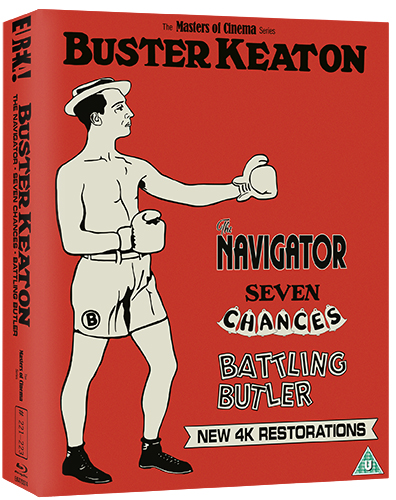
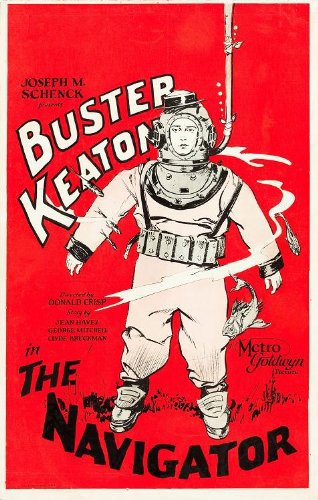
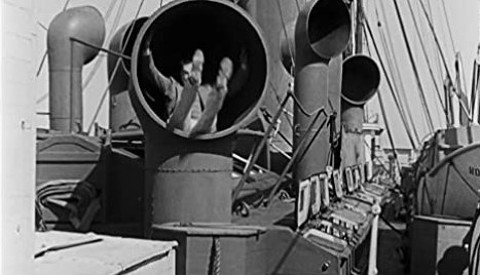


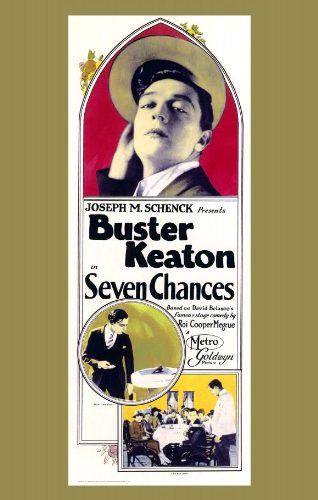

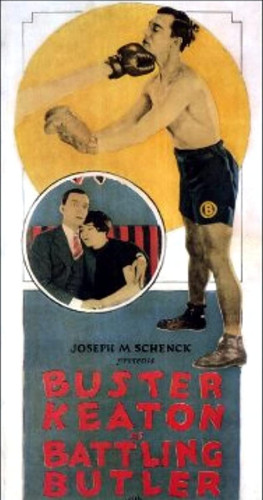
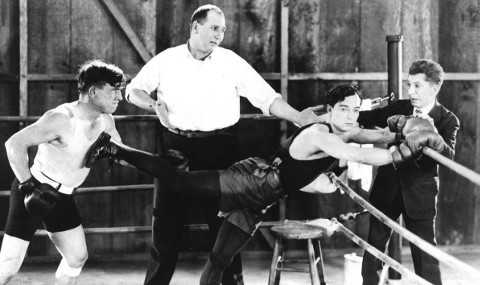


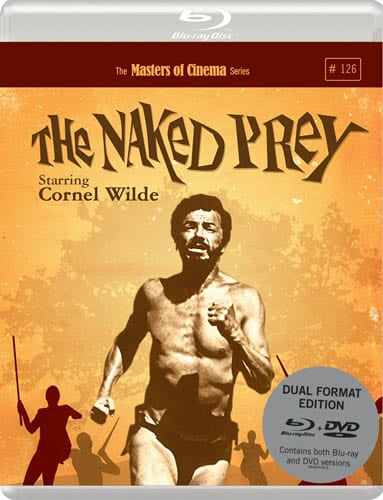
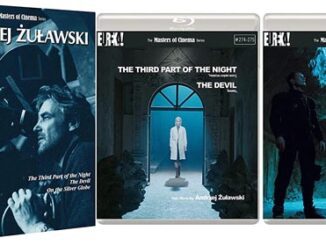

Dear Dr Lenera,
Thank you very much for your kind and generous praise of my work. Although the music score for SEVEN CHANCES is the 1995 recording, the scores for THE NAVIGATOR and BATTLING BUTLER are brand spanking new. The two features were presented at a different running speed from the previous editions, and therefore, required completely different musical settings. Cohen Media Group were incredibly supportive and very thoughtful concerning the presentations of their newest restorations. Thus, I am delighted to share with you that although I used some of the themes from the previous NAVIGATOR score, this version is an entirely new work, and if you have the interest or patience to compare this new version with the earlier edition, I think that you will agree that this newer release is very different from its predecessor. The music score I did for BATTLING BUTLER is absolutely different and easily more convincing that the 1995 version I had recorded.
Thank you, once again.
Robert Israel
Dear Robert
It was a pleasure, and thank you for this information. I had no idea that two of these scores were new; I usually do a small amount of research on previous releases when I review a film on Blu-ray, but I obviously missed this fact. I have not seen any earlier versions of these films but, seeing as film music is a big interest of mine, I will certainly check out and compare your scores if it is possible when I have the time. I feel that music is a vitally important ingredient in a film be it old or new and I almost always mention it in a review. Your scores for these three films really added to the experience of watching them – as you no doubt know silent movie music can be very hit and miss.
Dr Lenera
Hello, Do the lots of flecks mentioned in the film “Battling butler” occur around the 43rd mark. Just wondering if disk I have flawed, or is normal given the age of the film. Thank you.
Hi John
I quickly checked my review copy as I couldn’t remember exactly – and yes, it was 43 minutes in. So I think it’s safe to assume that this is due to the age of the film, and that section was badly damaged and therefore beyond total repair.